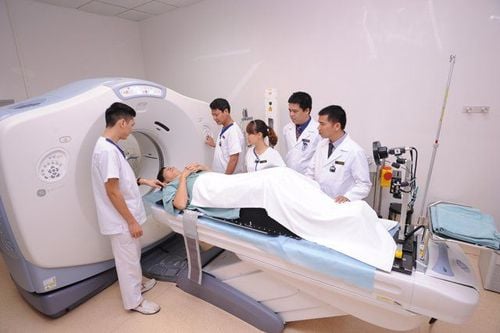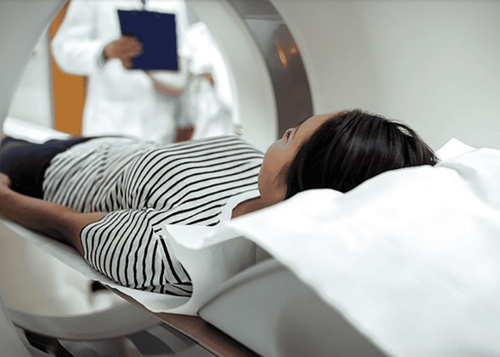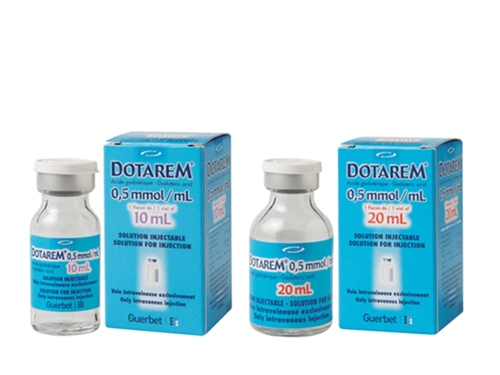This is an automatically translated article.
The article was professionally consulted by Specialist Doctor I Tran Cong Trinh - Radiologist - Radiology Department - Vinmec Central Park International General Hospital. The doctor has many years of experience in the field of diagnostic imaging.Magnetic resonance imaging, also known as MRI, is widely used because of its high accuracy, safety, non-invasiveness and non-X-ray use. This technique has many advantages over other imaging methods. such as CT, ultrasound... by high resolution images, multi-section surveys, giving sharp images of the part to be taken, and at the same time evaluating the properties of the tissue to be investigated.
1. What is magnetic resonance imaging?
Magnetic resonance imaging (MRI) is a method that helps doctors diagnose diseases by capturing images of organs in the body. From the resulting images, doctors will observe the amount of water inside the structure and from the assessment, make a judgment about the actual condition of the imaged part.2. What is magnetic resonance imaging technique for?
Magnetic resonance imaging can give clear images of most parts of the body. Therefore, it is useful when other techniques (such as radiography) do not provide the necessary information. It is often used to scan the brain and spinal cord to detect abnormalities and tumors. Even torn ligaments in the joint can be detected by magnetic resonance. Therefore, magnetic resonance is more commonly used after sports injuries.Magnetic resonance imaging method is especially valuable for the detection of brain, bone, and cardiovascular diseases and some cancers.

Chụp cộng hưởng từ hay còn gọi là MRI, được sử dụng rộng rãi bởi sự chính xác cao, an toàn, không xâm nhập và không dùng tia X
3. Advantages of magnetic resonance imaging compared to other imaging techniques
Magnetic resonance imaging is considered a breakthrough new technique in the medical industry by its progress and modernity, in which people use magnetic fields and radio waves to analyze and diagnose images.MRI technique is different from CT because it does not use X-rays, avoiding side effects from X-rays that can be dangerous for pregnant women or children. It is a non-invasive imaging technique.
Acquire multi-plane image: The forehead, horizontal, vertical or any inclined plane can be captured. The image obtained is complete, with quite high contrast. In particular, these images can be 3D reconstructed, making diagnosis much more accurate and efficient. This method uses magnetic fields and radio waves, so it does not cause the patient to have some unwanted side effects.
High soft tissue resolution.
Show better images when compared to computed tomography.
Cerebral vasculature can be taken without using contrast agent.
4. What are the disadvantages of magnetic resonance imaging?
Cannot be performed if patient has claustrophobia or claustrophobia, claustrophobia , surgical clips, eye or ear implants, etc. Resuscitation equipment cannot be brought into the imaging room. Implementation costs are still high5. Can I have magnetic resonance imaging if I have metal in my body?
Before taking the MRI, the technician will use specialized tools in the MRI room to check for foreign objects and metal devices placed in the body. Because magnetic resonance machines use strong magnetic fields, people wearing certain types of implants are not allowed to be photographed. Magnetic fields can deflect or damage medical devices with metal inside.In particular, small metal foreign bodies, located in the body of organs with loose tissue such as the brain, eyes, heart, lungs, next to large blood vessels... should not be taken for magnetic resonance imaging. The rest in other locations can be taken with magnetic resonance imaging.

Trước khi chụp cộng hưởng từ kỹ thuật viên sẽ sử dụng dụng cụ chuyên dùng trong phòng MRI để kiểm tra các dị vật và thiết bị kim loại được đặt trong cơ thể
6. The process of performing magnetic resonance imaging
The magnetic resonance machine is like a tunnel about 1.5 m long surrounded by a large magnet ring. The patient will lie on a long table that moves into the scanner. The signal receiving transducer will be placed behind, or around the body part to be examined. This helps detect small radio wave signals being emitted by your body. For each “image” taken, you need to lie still for a few minutes, or the image will be blurred.Magnetic resonance imaging is painless. The whole shooting process takes about 15-40 minutes. You may feel uncomfortable lying on the table during this time. Young children may need anesthesia to lie still during the procedure. In some cases, contrast medicine is injected into your body through a vein in your arm. This gives a clearer picture of certain organs or tissues that need to be examined.
The technician sits in the control room, next to the scanner and observes the patient through the window. However you can talk to them via the intercom, and you are also monitored via the screen.
7. How long does magnetic resonance imaging take?
It takes about 15-20 minutes to do. Then wait about 15 minutes for the patient to receive the results. However, for people with serious and complex medical conditions, it will take longer for the radiologist team to consult. The consultation time for complex cases can be several hours.Vinmec International General Hospital put into use the magnetic resonance imaging machine 3.0 Tesla Silent technology. The 3.0 Tesla Pioneer Signa magnetic resonance imaging machine with Silent technology from GE Healthcare (USA) is one of the most modern machines in the world.
Silent technology is especially beneficial for patients who are children, the elderly, weak health patients and patients undergoing surgery. Limiting noise, creating comfort and reducing stress for customers during the shooting process, helping to capture better quality images and shorten the shooting time. Magnetic resonance imaging technology is the technology applied in the most popular and safest imaging method today because of its accuracy, non-invasiveness and non-X-ray use.
Please dial HOTLINE for more information or register for an appointment HERE. Download MyVinmec app to make appointments faster and to manage your bookings easily.













